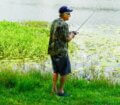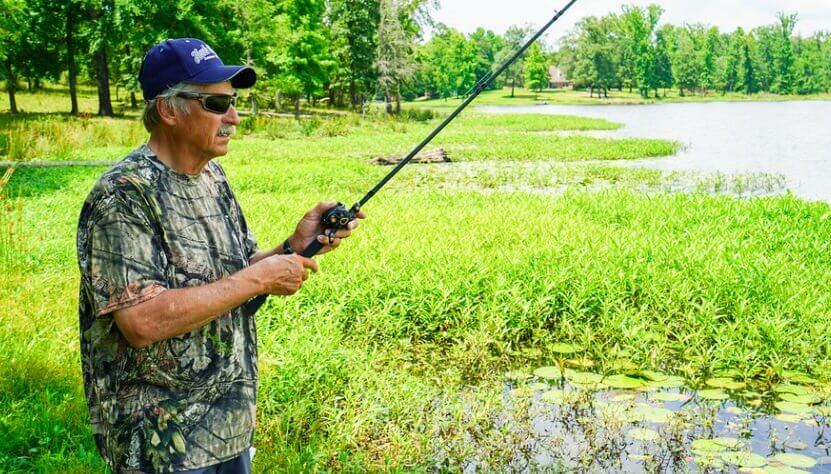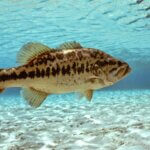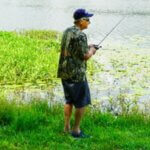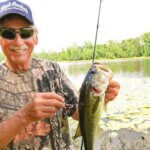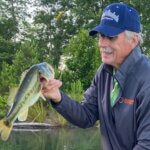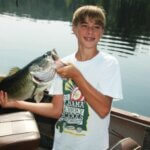Editor’s Note: South Carolina’s Hank Parker won two Bassmaster Classics before he moved into hosting and producing his TV shows, “Hank Parker’s Outdoor Magazine” and “On the Water with Hank Parker.” Parker manages the ponds on his farm intensively for bass and fishes them regularly. He films TV shows each year on his friends’ and neighbors’ farm ponds, gaining experience in farm-pond management and catching bass from farm ponds. He says, “Each farm pond is different and isn’t created or maintained in the same way. The history of the pond itself and the type of pond it is impacts how, where and when you’ll catch bass there. A friend has nine farm ponds – each with its own personality. I’ll fish different lures in each lake for bass. One of the ponds remains muddy almost all year, while another is crystal clear with little structure in it. Yet another pond homes plenty of structure. The clarity of the water, the type of pond and the kind of pond structure all play very-important roles in your lure selection and your bass-fishing success.”

Which Lures to Fish
In the South, many farm ponds and lakes have moss in them, and some have slime on their bottoms. I’ll often fish those with a drop-shot rig and/or a Carolina rig, maybe with a floating worm. With these two rigs, my lure may pick-up some moss off the bottom, but soft- plastic lures with no weights usually won’t get much moss or slime on them. The bass will be able to see a bait with no weight further and longer than they will if the soft plastic has a weight in front.
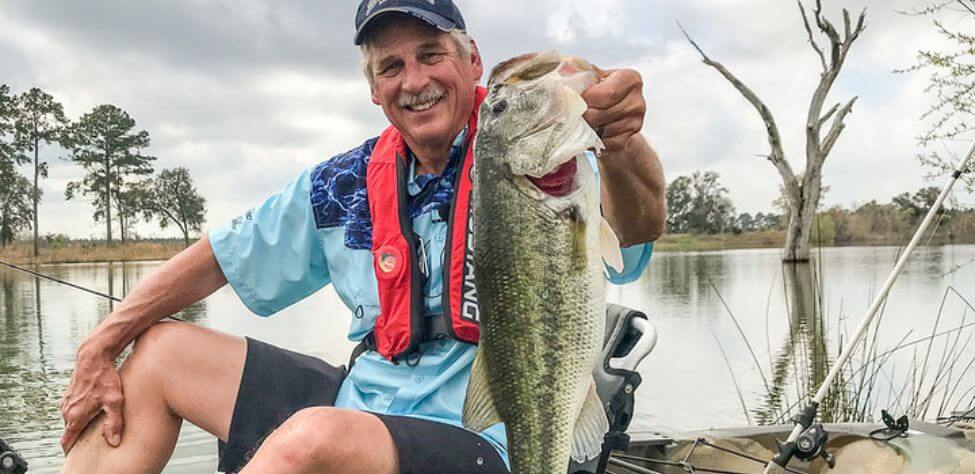
I’ll rig my lure Texas-style, hiding the hook’s point in the lure and using no weight. On a windy day, I may put a small split-shot weight about 6 inches up the line, however, that light shot won’t pick slime up across the bottom like a heavier sinker will. One of the weights I use with this tactic is a long and skinny Mojo weight.
I’ll fish a lake with moss or grass above the surface with my number-one lure – a weedless rubber frog – in the open spots in the grass first. I’ll cast the frog to land on the grass, then twitch it or move it into the open places in the grass and fish all the surface moss.
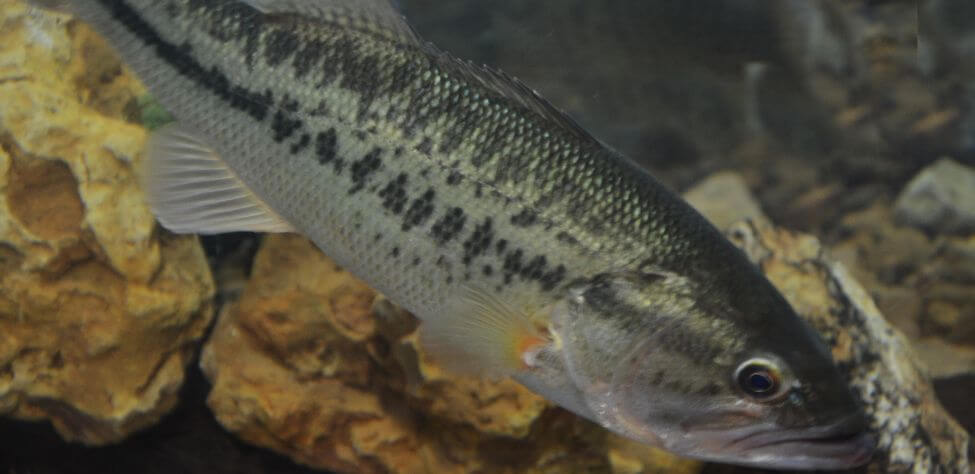
However, a bass may go up through the moss and not get the frog in its mouth. As soon as the bass blows-up on the frog, I’ll start winding my reel handle. I won’t set the hook, until I feel the bass on my line. But by winding my reel instead of jerking the frog, I leave the frog close to the area where the bass has blown-up on it. Then the fish may turn around and come back to attack that same frog on the surface.
If the bass blows-up on the frog and doesn’t attack a second time, I’ll cast a sinking worm tied on another rod into the hole in the grass the bass’s made when it’s missed the frog. I like the Berkley PowerBait MaxScent General sinking worm or the Senko.
On top of the grass, I’ll fish a Texas-rigged plastic worm with no weight on it. I also like a Power Jerk Shad that resembles a fluke that I may fish on the edge of the moss, just under the surface, with a barrel swivel as a weight on the main line, tied to a 2-4 foot leader.
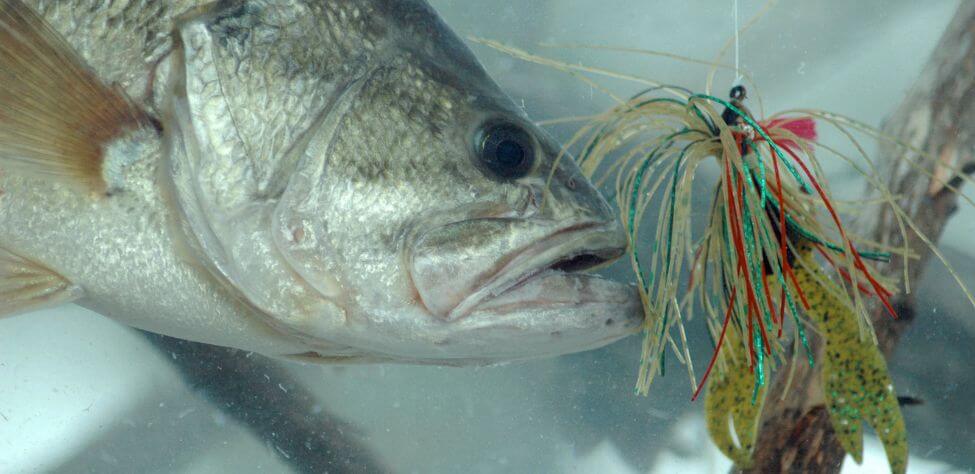
How to Get Bass Out of Grass or Moss
In a mossy pond, I’ll use braided line, like Spiderwire or Berkley braid. The difference between braided line and monofilament line is that when you hook a big bass in that moss or grass on monofilament line, the bass usually will go-down, wrap that line around the vegetation and break free from the hook. But with braided line, once you set the hook, it’ll cut through the moss or grass and allow you to get your bass out. Your braided line may be the diameter of 10-pound-test line, but has the strength of 30-pound line.
I believe more farm-pond bass have been caught on a Zebco 33 Spincast reel that holds monofilament line, than any other rod-and-reel combination made. I like a 7-foot medium-heavy-action rod when fishing mossy farm ponds because its length has more leverage to get the bass out of the grass or move them through the grass than a shorter rod does. However, if the pond has trees hanging over the water, I prefer a 5-1/2 footer with a pistol handle to cast around the limbs of that tree in the water or under willow trees hanging out over the water.
Tomorrow: Bass Fishing Various Types of Farm Ponds
Expert Guidebooks on Bass Fishing: Best Sellers

If you want to become the best you can be, find someone who’s already become the best at what you want to do and follow his or her instructions. This is what I’ve done in my new book, Bass Pros’ Season by Season Tactics.
In this book, I’ve chosen some of the best bass fishermen to give you advice on how to find and catch bass during each period of a bass fish’s life, including professionals like Kevin VanDam, Denny Brauer, David Fritts, Rick Clunn, Larry Nixon, George Cochran, Mark Davis, Woo Daves, Gary Klein, Davy Hite, Michael Iaconelli, Skeet Reese, Mark Rose, and Shaw Grigsby.
My hope is that this book will help you find and catch more bass at every time of the year and each day you’re on the water. The men included in this book are some of the best mentors I know of for successful bass fishing anywhere in the nation.
VERSIONS: AUDIBLE & PRINT
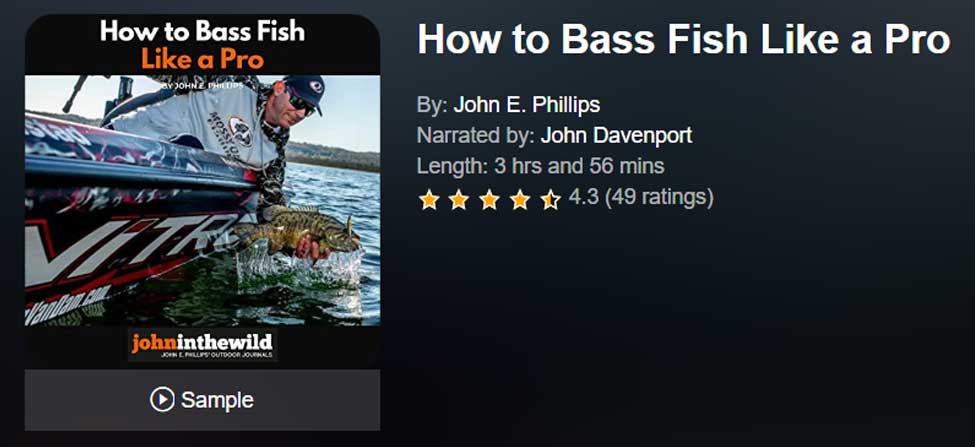
How to Bass Fish Like a Pro
If you could sit down and interview some of the best pro bass fishermen in the world, what would you want them to tell you to help you improve your bass fishing skills?
In this book, How to Bass Fish Like a Pro, Kevin VanDam explains how he catches bass consistently, and how he fishes all 12 months of the year. In the bonus chapters, he will tell you how to fish for hot-weather bass.
Denny Brauer will tell you the ways he hates to fish, how he picks the best fishing lures for different water and weather conditions, and will give you his best fishing tips for hot weather. In Brauer’s bonus chapters, he’ll teach you when to flip a jig, a tube, or a creature bait and tell you his three tips for how to be a better fisherman.
Mark Davis, in Chapter 3 of the book, explains his five secrets to becoming a better bass fisherman, how to turn your bass fishing around to the positive side, and how to catch hot-weather bass. In the bonus chapter, you’ll get six different interviews with Davis, where he tells you: three tips for becoming a better bass fisherman; his three favorite bass lures; and how to keep a big bass on the line and get it to the boat.
James Niggemeyer tells you how to become a bass pro. He also tells you how to catch bass when the weather sizzles. In Niggemeyer’s bonus chapter, he explains how to move from being a bass-club fisherman up to being a pro.
Mark Rose will explain his five favorite go-to bass lures, and how to catch bass in the middle of the summer.
In this book, you’ll hear from top-performing pro fishermen about how they catch big bass consistently, and what they do to win millions of dollars as professional bass fishermen.
VERSIONS: AUDIBLE, KINDLE & PRINT
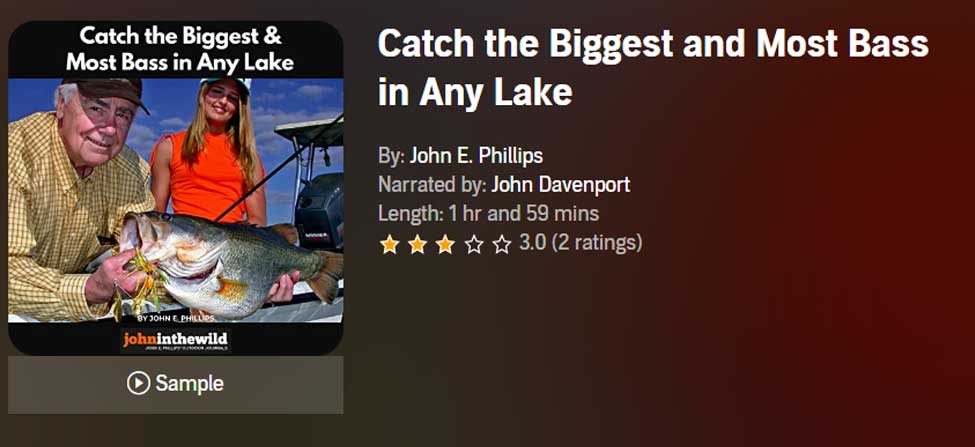
Catch the Biggest and Most Bass in Any Lake
If you were having open-heart surgery at the hospital, you’d want the best doctor with the most experience and the latest equipment and techniques that money could buy to do your operation. You’d study these doctors’ credentials to learn who was the best.
This is the same type of research that author John E. Phillips has done with the best bass fishermen in the nation to solve the problem of how to find and catch the biggest and the most bass in any body of water that he fishes.
This is the same type of research that author John E. Phillips has done with the best bass fishermen in the nation to solve the problem of how to find and catch the biggest and the most bass in any body of water that he fishes.
In this book, you’ll hear about the techniques, tips, baits, lures, and tackle that 18 of the nation’s best professional fishermen use to support their families by winning bass tournaments and catching the most and the biggest bass they can in every tournament they fish.
Most of these anglers are Bassmaster Classic winners, Megabucks winners, Angler-of-the-Year and FLW Tour winners – like Rick Clunn, Kevin VanDam, George Cochran, Mark Davis, Paul Elias, Skeet Reese, Larry Nixon, Hank Parker, Ken Cook, Denny Brauer, Alton Jones, and Jay Yelas.
Also, every serious bass fisherman should know Timmy Horton, Mark Rose, Randy Dearman, Harold Allen, Mike Wurm, and Shaw Grigsby, men whose tactics you’ll find in this book. To learn how to fish for bass and change your bass-fishing trips from fishing trips to catching trips, this book is a must-have.
VERSIONS: AUDIBLE, KINDLE & PRINT
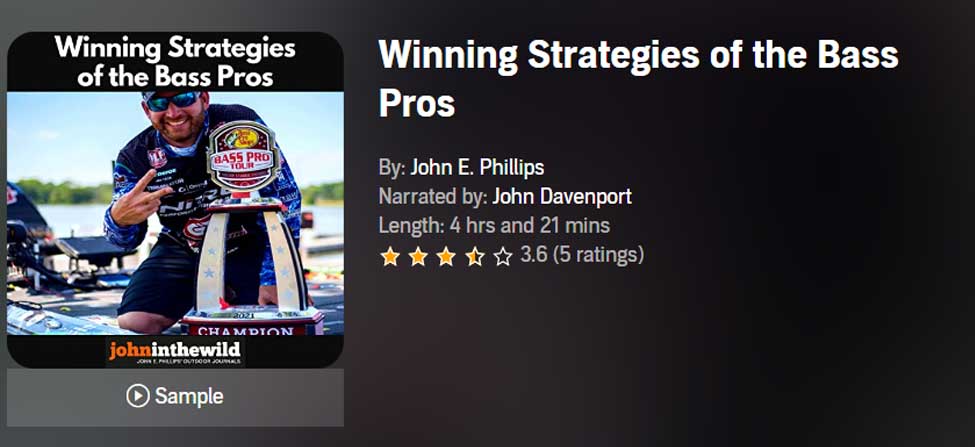
Winning Strategies of the Bass Pros
I learned many years ago if you want to be the best you can be, then you need to learn from the best – particularly when you want to be the best bass fisherman possible. That’s why I’ve written Winning Strategies of the Bass Pros about 11 top bassers.
If you’re wondering at what age you can start learning about bass fishing, you’ll see in the first two chapters about two young men who have come up through the ranks of collegiate bass tournaments – Jordan Lee, who won the Bassmaster Classic in 2017, and Dustin Connell, who won $100,000 in a B.A.S.S. Elite Series tournament in Mississippi in 2017. Top-name pros on both the B.A.S.S. circuit and the FLW circuit are in this book, including Kevin VanDam, Jay Yelas, George Cochran, Rick Clunn, Larry Nixon, Woo Daves, Randy Howell, Scott Canterbury, and Gary Klein.
VERSIONS: AUDIBLE, KINDLE & PRINT
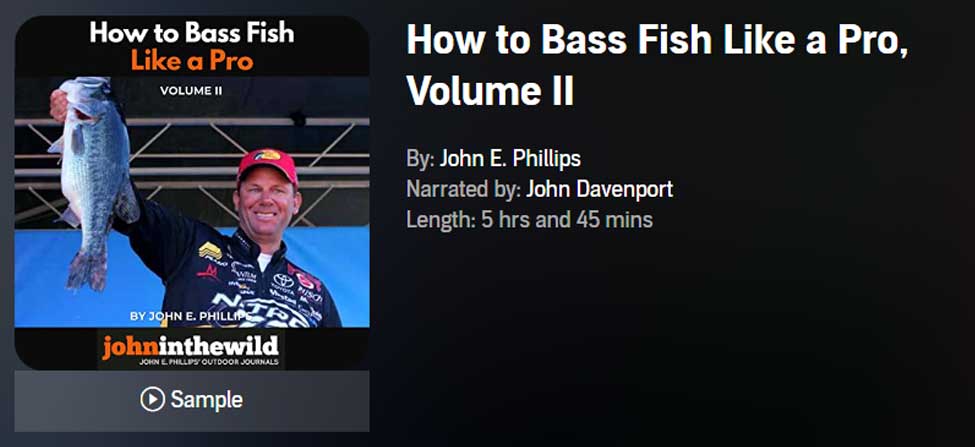
In How to Bass Fish Like a Pro, Volume II, you’ll learn tips and tactics from 21+ Bassmaster Classic winners, two Major League Fishing champions, and 20+ Bassmaster Anglers of the Year about some of the dramatic changes in bass fishing, like:
Depth Finders: You need the latest and greatest depth finders available, since they’re the brains of a bass boat with maps, GPS, side scanning, down scanning, and forward scanning features that enable you to see underwater structures and fish 100-feet away with a 360-degree view. Today’s competitive bass anglers may have four or five depth finders located on the consoles and the bows of their boats.
Other Changes in Equipment: Power fishing for bass using heavy line and rods, big baits, and bait-casting reels that resemble winches have given way to finesse fishing and new techniques like fishing the Ned Rig, the Neko Rig, the Chicken Rig, and the Tokyo Rig on spinning tackle and line as small as 6-10 pounds.
The Growth in Youth and College Competitions for Bass: A young person can begin competition fishing as early as the second grade and continue throughout high school. After that, if the competitor qualifies, he/she may win a scholarship to fish on a college team that eventually may lead them to a professional bass-fishing career.
Changes in the Ways Anglers Bass Fish: Many of the most-consistent winners never pick-up their rods to fish during pre-fishing. Instead, they’ll idle across the water, dropping waypoints from their electronics in places where they’ve identified schools of bass holding. These contestants will have at least 50-250 locations, where they’ve pinpointed schools of bass before a tournament starts.
VERSIONS: AUDIBLE, KINDLE & PRINT


